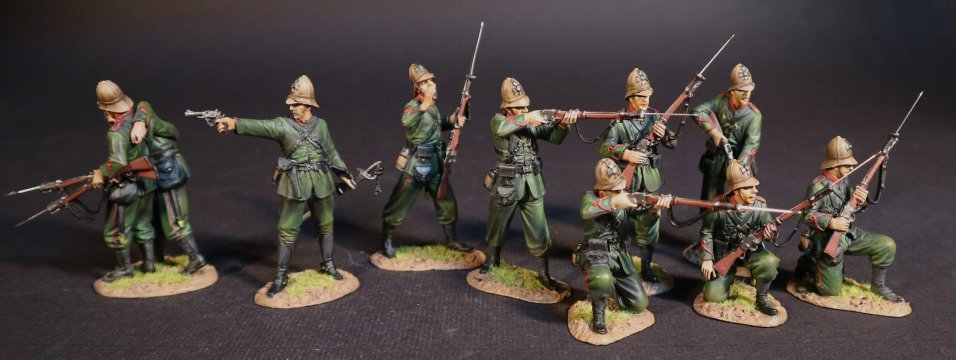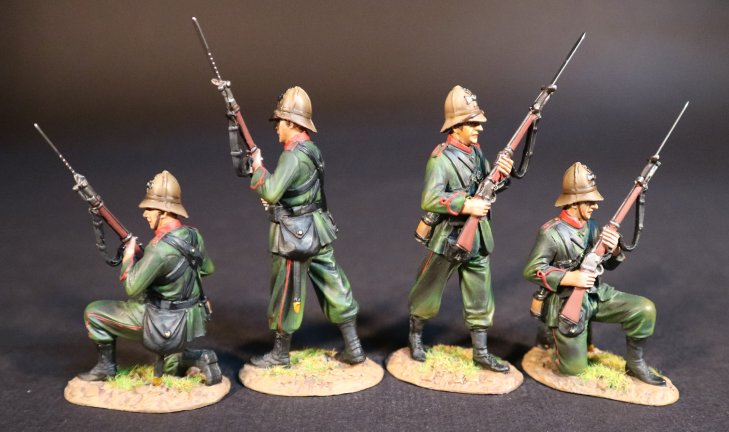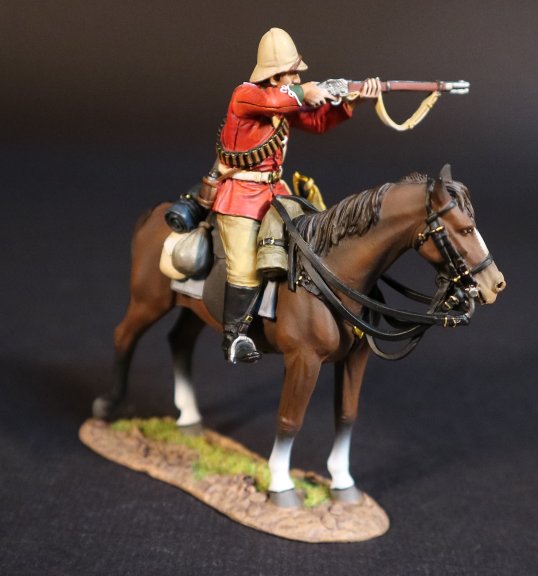- Joined
- Feb 2, 2011
- Messages
- 2,383
NEW RELEASES FOR JANUARY 2025
THE ANGLO ZULU WAR
THE BATTLE OF GINGINDHLOVU, 2nd APRIL 1879.
The Battle of Gingindhlovu was fought on 2nd April 1879 between a British relief column sent to break the siege at Eshowe, and a Zulu impi of king Cetshwayo.
The British soldier would refer to it as the Battle of “GIN GIN I LOVE YOU”.
Charles Pearson had led No.1 column of the British invasion force across the Tugela River to establish an advanced base at Eshowe. Having set up a base at a deserted Norwegian mission station, the British found themselves besieged.
A relief column was organized by Lord Chelmsford and departed Fort Tenedos on 29th March to relieve the garrison.
Chelmsford’s relief force comprised 3,390 Europeans, and 2,280 Africans.
Lord Chelmsford ensured his men spent much time laagering and entrenching their camp at the end of each day, and kept ammunition boxes open and at the ready.
Although this was slow progress, Pearson’s observers at Eshowe were able to see the relief column entrenched on the south bank of the Neyzane, on the evening of the 1st April.
The Zulu impi was composed of 12,000 warriors, some of whom were Isandlwana veterans drawn from regiments in the main Zulu army, while the remainder were warriors who lived in the vicinity of Eshowe.
Many of the Zulu commanders wanted to attack the relief column that night, but Prince Dabulamanzi KaMpande, who was half brother to king Cetshwayo and commander of the impi’s right wing, convinced them to wait until morning.
At dawn on 2 April 1879, the morning sun revealed muddy ground and a heavy mist. Chelmsford had decided after hearing Dunn's report to not continue on toward Eshowe early the next morning. Instead, he would deploy units of the Natal Native Contingent to feel for the Zulus. As the NNC were preparing to advance shots were heard from the night pickets still on duty. The impi was advancing; the main force split into two columns before crossing the Ineyzane and assuming the "chest and horns" formation. The left horn sharply curved to the right to assault the laager's north-east corner, while the "chest" gently curved toward the north face of the laager.
Another force passed Misi Hill and approached the laager, forming the impi’s right horn.
The buffalo formation came in at a run on the three sides of the laager as Chelmsford had wanted; at a range of 300–400 yd (270–370 m) the British infantry opened fire, supported by the Gatling guns and rockets.
Zulu marksmen caused a few casualties within the laager, but the defenders kept the Zulus at bay.
Although the Zulu regiments made persistent rushes to get within stabbing range, their charges lacked the drive and spirit that had pushed them forward at Isandlwana and Rorke’s Drift.
The only zulu to reach the laager was a ten year old boy, who was immediately taken prisoner by members of the naval brigade and later served as a kind of mascot on their ship, Boadicea.
Around 7am, the main impi attack had been halted. Chelmsford ordered his mounted troops to attack, followed by the NNC.
Many zulu were killed as they withdrew.
Chelmsford had begun to avenge the Imperial dead of Isandlwana, but for the present he was content to relieve Pearson and return to Natal.
THE 3rd BATTALION 60th KING’S ROYAL RIFLE CORPS

This battalion was stationed at Colchester when, on 12th February 1879, it was ordered to Natal. Soon after its arrival it was attached to the column that was organized for the relief of Eshowe.
On 2nd April the battalion was engaged at the Battle of Gingindhlovu and took part in the subsequent relief of Eshowe.
Six companies of the 3rd Battalion of the 60th Regiment were to defend the north face of the laager at Gingindhlovu. The men of the 60th rifles manning the north face bore the brunt of the zulu ”Chest” attack, and were under enormous pressure. They were to hold their position, and at 06.40 am the Zulu chest confronting them began to retire into the long grass.
Chelmsford ordered Barrow’s Mounted Infantry and Natal Volunteers out of the north side of the laager in pursuit, but the zulu rallied and drove them back. The chest then circled to their right to reinforce the left division of the right horn attacking the laager’s western face.
At 7 am the right division of the right horn began a determined assault on the laager’s southern face under Dabulamanzi’s leadership. Chelmsford ordered two companies of the 60th out of the north face in support of the hard pressed 91st regiment.
Dabulamanzi’s attack stalled under the heavy fire, rolling around for a brief and unsuccessful attempt at the eastern face of the laager.
During the second invasion of Zululand the battalion formed part of the 2nd Brigade of Crealock’s 1st Division.

GG60-06
THE ANGLO ZULU WAR
THE BATTLE OF GINGINDHLOVU, 2nd APRIL 1879,
THE ESHOWE RELIEF COLUMN,
3rd BATTALION 60th KING’S ROYAL RIFLE CORPS,
2 INFANTRY

GG60-06N
THE ANGLO ZULU WAR
THE BATTLE OF GINGINDHLOVU, 2nd APRIL 1879,
THE ESHOWE RELIEF COLUMN,
3rd BATTALION 60th KING’S ROYAL RIFLE CORPS,
4 INFANTRY
MOUNTED INFANTRY
At the beginning of the campaign Chelmsford had no regular cavalry regiments at his disposal, which was a setback given the cavalry traditional role of scouting and pursuit.
He did however have two understrength squadrons of Mounted Infantry, who were distributed throughout the invading columns

The Mounted Infantry consisted of selected soldiers from infantry regiments mounted on locally acquired horses.
During the Zulu war the men of the mounted infantry, chosen from nearly every infantry battalion, wore their regiment’s tunic, cord breeches and riding boots.
They were armed with Martini-Henry rifles, and instead of the usual infantry equipment carried a bandolier.
Despite the mixed origins of this Mounted Infantry force, it performed extremely well, and paved the way for greater reliance on Mounted Infantry units in later campaigns.
Major P. H. S. Barrow was to command the 70 Mounted Infantry at Gingindhlovu, and had armed the men with sabres.

GGMI-03
THE ANGLO ZULU WAR
THE BATTLE OF GINGINDHLOVU, 2nd APRIL 1879,
THE ESHOWE RELIEF COLUMN,
MOUNTED INFANTRY
**PLEASE CONTACT YOUR LOCAL DEALER FOR FURTHER INFORMATION**
THE ANGLO ZULU WAR
THE BATTLE OF GINGINDHLOVU, 2nd APRIL 1879.
The Battle of Gingindhlovu was fought on 2nd April 1879 between a British relief column sent to break the siege at Eshowe, and a Zulu impi of king Cetshwayo.
The British soldier would refer to it as the Battle of “GIN GIN I LOVE YOU”.
Charles Pearson had led No.1 column of the British invasion force across the Tugela River to establish an advanced base at Eshowe. Having set up a base at a deserted Norwegian mission station, the British found themselves besieged.
A relief column was organized by Lord Chelmsford and departed Fort Tenedos on 29th March to relieve the garrison.
Chelmsford’s relief force comprised 3,390 Europeans, and 2,280 Africans.
Lord Chelmsford ensured his men spent much time laagering and entrenching their camp at the end of each day, and kept ammunition boxes open and at the ready.
Although this was slow progress, Pearson’s observers at Eshowe were able to see the relief column entrenched on the south bank of the Neyzane, on the evening of the 1st April.
The Zulu impi was composed of 12,000 warriors, some of whom were Isandlwana veterans drawn from regiments in the main Zulu army, while the remainder were warriors who lived in the vicinity of Eshowe.
Many of the Zulu commanders wanted to attack the relief column that night, but Prince Dabulamanzi KaMpande, who was half brother to king Cetshwayo and commander of the impi’s right wing, convinced them to wait until morning.
At dawn on 2 April 1879, the morning sun revealed muddy ground and a heavy mist. Chelmsford had decided after hearing Dunn's report to not continue on toward Eshowe early the next morning. Instead, he would deploy units of the Natal Native Contingent to feel for the Zulus. As the NNC were preparing to advance shots were heard from the night pickets still on duty. The impi was advancing; the main force split into two columns before crossing the Ineyzane and assuming the "chest and horns" formation. The left horn sharply curved to the right to assault the laager's north-east corner, while the "chest" gently curved toward the north face of the laager.
Another force passed Misi Hill and approached the laager, forming the impi’s right horn.
The buffalo formation came in at a run on the three sides of the laager as Chelmsford had wanted; at a range of 300–400 yd (270–370 m) the British infantry opened fire, supported by the Gatling guns and rockets.
Zulu marksmen caused a few casualties within the laager, but the defenders kept the Zulus at bay.
Although the Zulu regiments made persistent rushes to get within stabbing range, their charges lacked the drive and spirit that had pushed them forward at Isandlwana and Rorke’s Drift.
The only zulu to reach the laager was a ten year old boy, who was immediately taken prisoner by members of the naval brigade and later served as a kind of mascot on their ship, Boadicea.
Around 7am, the main impi attack had been halted. Chelmsford ordered his mounted troops to attack, followed by the NNC.
Many zulu were killed as they withdrew.
Chelmsford had begun to avenge the Imperial dead of Isandlwana, but for the present he was content to relieve Pearson and return to Natal.
THE 3rd BATTALION 60th KING’S ROYAL RIFLE CORPS

This battalion was stationed at Colchester when, on 12th February 1879, it was ordered to Natal. Soon after its arrival it was attached to the column that was organized for the relief of Eshowe.
On 2nd April the battalion was engaged at the Battle of Gingindhlovu and took part in the subsequent relief of Eshowe.
Six companies of the 3rd Battalion of the 60th Regiment were to defend the north face of the laager at Gingindhlovu. The men of the 60th rifles manning the north face bore the brunt of the zulu ”Chest” attack, and were under enormous pressure. They were to hold their position, and at 06.40 am the Zulu chest confronting them began to retire into the long grass.
Chelmsford ordered Barrow’s Mounted Infantry and Natal Volunteers out of the north side of the laager in pursuit, but the zulu rallied and drove them back. The chest then circled to their right to reinforce the left division of the right horn attacking the laager’s western face.
At 7 am the right division of the right horn began a determined assault on the laager’s southern face under Dabulamanzi’s leadership. Chelmsford ordered two companies of the 60th out of the north face in support of the hard pressed 91st regiment.
Dabulamanzi’s attack stalled under the heavy fire, rolling around for a brief and unsuccessful attempt at the eastern face of the laager.
During the second invasion of Zululand the battalion formed part of the 2nd Brigade of Crealock’s 1st Division.

GG60-06
THE ANGLO ZULU WAR
THE BATTLE OF GINGINDHLOVU, 2nd APRIL 1879,
THE ESHOWE RELIEF COLUMN,
3rd BATTALION 60th KING’S ROYAL RIFLE CORPS,
2 INFANTRY

GG60-06N
THE ANGLO ZULU WAR
THE BATTLE OF GINGINDHLOVU, 2nd APRIL 1879,
THE ESHOWE RELIEF COLUMN,
3rd BATTALION 60th KING’S ROYAL RIFLE CORPS,
4 INFANTRY
MOUNTED INFANTRY
At the beginning of the campaign Chelmsford had no regular cavalry regiments at his disposal, which was a setback given the cavalry traditional role of scouting and pursuit.
He did however have two understrength squadrons of Mounted Infantry, who were distributed throughout the invading columns

The Mounted Infantry consisted of selected soldiers from infantry regiments mounted on locally acquired horses.
During the Zulu war the men of the mounted infantry, chosen from nearly every infantry battalion, wore their regiment’s tunic, cord breeches and riding boots.
They were armed with Martini-Henry rifles, and instead of the usual infantry equipment carried a bandolier.
Despite the mixed origins of this Mounted Infantry force, it performed extremely well, and paved the way for greater reliance on Mounted Infantry units in later campaigns.
Major P. H. S. Barrow was to command the 70 Mounted Infantry at Gingindhlovu, and had armed the men with sabres.

GGMI-03
THE ANGLO ZULU WAR
THE BATTLE OF GINGINDHLOVU, 2nd APRIL 1879,
THE ESHOWE RELIEF COLUMN,
MOUNTED INFANTRY
**PLEASE CONTACT YOUR LOCAL DEALER FOR FURTHER INFORMATION**

